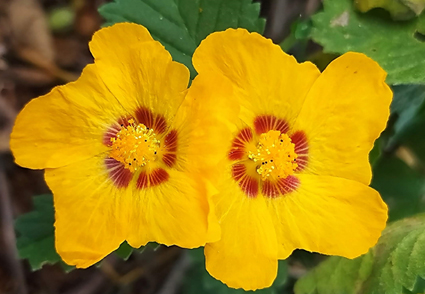Abstract
New synonyms and lectotypes in Sida sect. Cordifoliae (Malvaceae, Malveae) are proposed here and reveal the first record and extension of the distribution area of Sida maculata to the Brazilian semi-arid region. The species was first described in the 18th century for the Caribbean islands of Cuba and the Dominican Republic and for a long time was confused with S. cordifolia, from which it is unquestionably distinct in its leaves, inflorescences and flowers. In Brazil, S. maculata is widely distributed from Maranhão to the north of Minas Gerais and was identified for almost a century in herbaria and local floristic treatments as S. galheirensis. Discussions and photographs of types of S. maculata and related taxa are presented, as well as an updated map of the species’ geographical distribution.
References
- Bovini, M. (2023) Sida in Flora e Funga do Brasil. Jardim Botânico do Rio de Janeiro. Available from: https://floradobrasil.jbrj.gov.br/FB9203 (accessed 14 November 2023)
- Burchhem, G. (1965) A bibliographical account of L'Héritier's Stirpes Novae. Huntia 2: 29–58.
- Candolle, A.P. de. (1824) Prodromus systematis naturalis regni vegetabilis, sive, Enumeratio contracta ordinum generum specierumque plantarum huc usque cognitarium, juxta methodi naturalis, normas digesta. Sumptibus Sociorum Treuttel et Würtz, Parisii, Pars Prima, 745 pp. https://doi.org/10.5962/bhl.title.286
- Cavanilles, A.J. (1785) Dissertatio botanica de Sida, et de quibusdam plantis quae cum illa affinitatem habent. Franciscum Amb. Didot., Parisiis, 47 pp.
- Fryxell, P.A. (1985) Sidus Sidarum-V. The north and central American species of Sida. Sida 11: 62–91.
- Fryxell, P.A. (2009) A new South American subsection of Sida sect. Nelavaga (Malvaceae) with two new species. Lundellia 12: 15–27. https://doi.org/10.25224/1097-993X-12.1.15
- Krapovickas, A. (2003) Sida sección Distichifolia (Monteiro) Krapov. comb. nov., stat. nov. (Malvaceae-Malveae). Bonplandia 12: 83–121. https://doi.org/10.30972/bon.121-41407
- L’Héritier, C.L. (1789) Stirpes novae, aut minus cognitae, quas descriptionibus et iconibus illustravit. Fasc. 5. Ex Typographia Philippi-Dionysii Pierres, Régis Typographi Ordinarii, viâ San Jacobaeâ, Parisiis, pp. 103–181.
- Linnaeus, C. von (1753) Species plantarum: exhibentes plantas rite cognitas, ad genera relatas, cum differentiis specificis, nominibus trivialibus, synonymis selectis, loci natalibus, secundum systema sexuale digestas. Impensis Direct. Laurentii Salvii, Holmiae, pp. 561–1200. https://doi.org/10.5962/bhl.title.59734
- Monteiro-Filho, H.C. (1936) Monografia da Malvaceae Brasileiras. Fasc. I. O gênero Sida. Revisão das espécies brasileiras. 1ª Parte. Chave das espécies sul americanas e novidades brasileiras. Ministério da Agricultura, Departamento Nacional de Produção Vegetal, Serviço de Plantas Têxteis, Rio de Janeiro, 56 pp.
- Monteiro-Filho, H.C. (1968) Novidades no gênero Sida. Anais XIX Congresso Nacional de Botânica, Universidade Federal do Ceará, Fortaleza, pp. 41–49.
- Olson, D.M., Dinerstein, E., Wikramanayake, E.D., Burgess, N.D., Powell, G.V.N., Underwood, E.C., D’Amico, J.A., Itoua, I., Strand, H.E., Morrison, J.C., Loucks, C.J., Allnutt, T.F., Ricketts, T.H., Kura, Y., Lamoreux, J.F., Wettengel, W.W., Hedao, P. & Kassem, K.R. (2001) Terrestrial ecoregions of the world: a new map of life on earth. Bioscience 51 (11): 933–938. https://doi.org/10.1641/0006-3568(2001)051[0933:TEOTWA]2.0.CO;2
- POWO (2023) Sida in Plants of the World Online. Royal Botanic Gardens, Kew. Available from: http://www.plantsoftheworldonline.org/ (accessed 11 September 2023)
- SpeciesLink (2023) Centro de Referência em Informação Ambiental, CRIA. Available from: https://specieslink.net/search/ (accessed 11 September 2023)
- Stafleu, F.A. & Cowan, R.S. (1981) Taxonomic literature: a selective guide to botanical publications and collections with dates, commentaries and types. Vol. 3. 2nd ed. Bohn, Schetelma & Holkema, Utrecht, 980 pp. https://doi.org/10.5962/bhl.title.48631
- Teixeira, L.P., Lughada, E.N., Silva, M.V.C. & Moro, M.F. (2021) How much of the Caatinga is legally protected? An analysis of temporal and geographical coverage of protected areas in the Brazilian semiarid region. Acta Botanica Brasilica 35 (3): 473–485. https://doi.org/10.1590/0102-33062020abb0492
- Thiers, B. (2023+continuously updated) Index Herbariorum: A global directory of public herbaria and associated staff. New York Botanical Garden’s Virtual Herbarium. Available from: http://sweetgum.nybg.org/ih/ (accessed 18 September 2023)
- Turland, N.J., Wiersema, J.H., Barrie, F.R., Greuter, W., Hawksworth, D.L., Herendeen, P.S., Knapp, S., Kusber, W.-H., Li, D.-Z., Marhold, K., May, T.W., McNeill, J., Monro, A.M., Prado, J., Price, M.J. & Smith, G.F. (Eds.) (2018) International Code of Nomenclature for algae, fungi, and plants (Shenzhen Code) adopted by the Nineteenth International Botanical Congress Shenzhen, China, July 2017. Regnum Vegetabile 159. Koeltz Botanical Books, Glashütten, 304 pp. https://doi.org/10.12705/Code.2018
- Ulbrich, E. (1924) Malvaceae. Plantae Luetzelburgianae Brasilienses IV. Notizblatt des Botanischen Gartens und Museums zu Berlin-Dahlem 9: 40–41. https://doi.org/10.2307/3994428
- Velloso, A.L., Sampaio, E.V.S.B. & Pareyn, F.G.C. (2002) Ecorregiões propostas para o bioma caatinga. Associação Plantas do Nordeste, The Nature Conservancy do Brasil, Recife, 76 pp.
- Weakley, A.S., Poindexter, D.P., LeBlond, R.J., Sorrie, B.A., Karlsson, C.H., Williams, P.J., Bridges, E.L., Orzell, S.L., Keener, B.R., Weeks, A., Noyes, R.D., Flores-Cruz, M., Diggs, J.T., Gann, G.D. & Floden, A.J. (2017) New combinations, rank changes, and nomenclatural and taxonomic comments in the vascular flora of the southeastern United States. II. Journal of the Botanical Research Institute of Texas 11 (2): 291–325. https://doi.org/10.17348/jbrit.v12.i1.910


